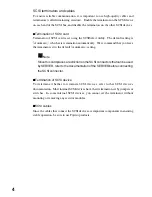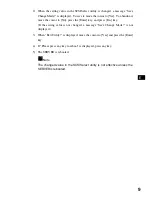
11
E
Advanced Configuration Options
Default settings
Reset SCSI Bus at IC Initialization
Enabled
Display <Ctrl-A> Message During BIOS Initialization
Enabled
Extended BIOS Translation for DOS Drives > 1 GByte*
2
Enabled
Verbose/Silent Mode
Verbose
Host Adapter BIOS (Configuraiton Utility Reserves
Enabled
BIOS space)
(To be set to
"Disabled: scan bus"
when not connecting
a Boot Device)
Support Removable Disks Under BIOS as Fixed Disks*
2
Boot only
BIOS Support for Bootable CD-ROM*
2
Enabled
BIOS Support for Int13 Extensions*
2
Enabled
*2 Enabled only when Host Adapter-BIOS is enabled
■
Explanation of each setting
1
SCSI Bus Interface Definitions
・ Host Adapter SCSI ID
Selecting this option allows you to set the SCSI ID of this card. The default
setting is 7. In this case, this card has the highest priority on the SCSI bus. We
recommend that you leave this card ID set to 7.
・ SCSI Parity Checking
Selecting this option allows you to determine whether data is transferred
accurately on the SCSI bus or whether this card checks the parity. The default
setting is 「Enabled」. If any SCSI device being connected to this card does not
support the SCSI parity function, you set the SCSI Parity Checking function to
「Disabled」. Most SCSI devices support SCSI parity. If you do not know
whether the SCSI device supports SCSI parity, refer to that SCSI device's
documentation.
2
Host Adaptor SCSI Termination
A SCSI termination can be constructed by this card if this optional connector is used
together. The default setting of this card is
Automatic
, and the user is advised to
use this card letting it remain with the default setting of
Automatic
3
Boot Device Options
Setting the boot device enables you to specify the SCSI device used to boot your
SERVER.














































